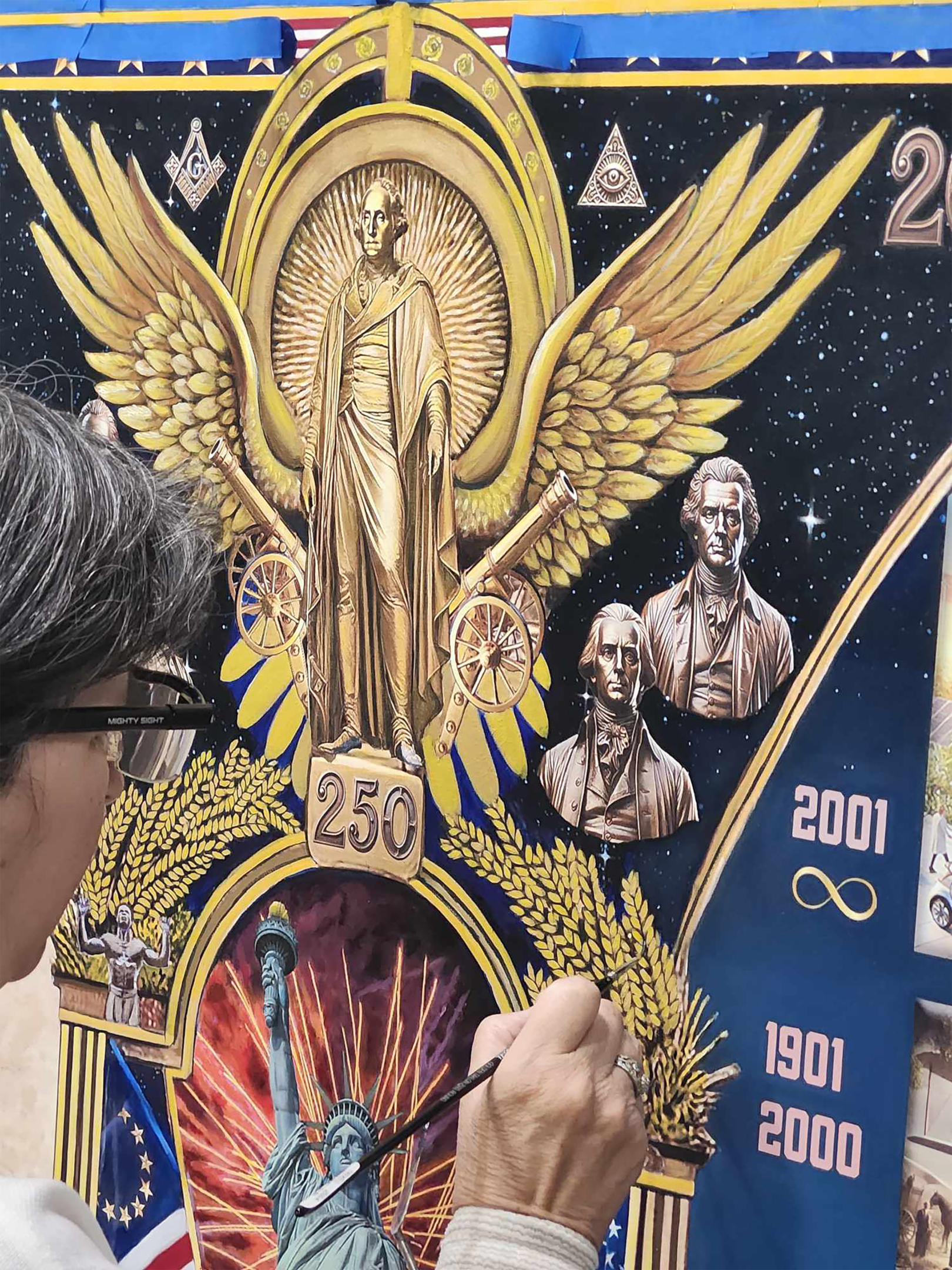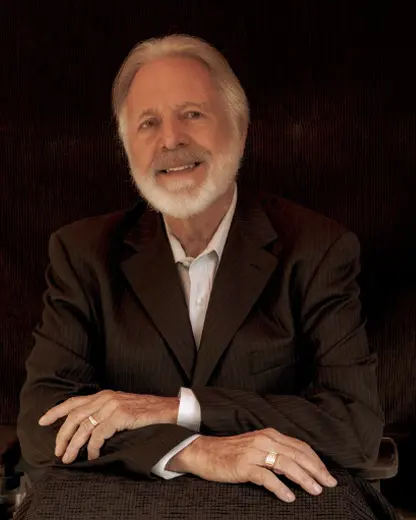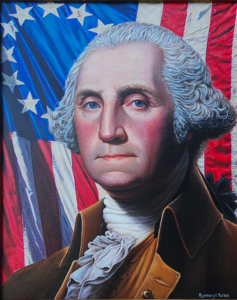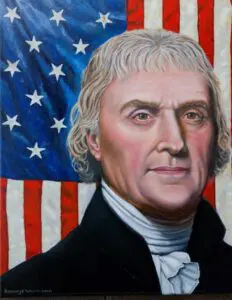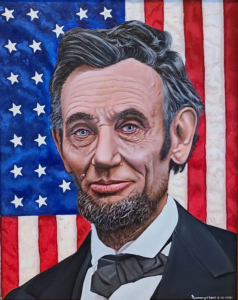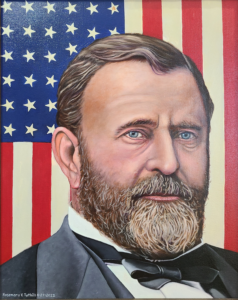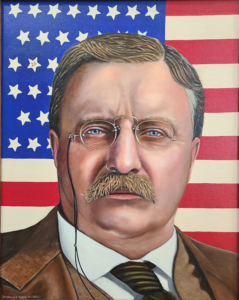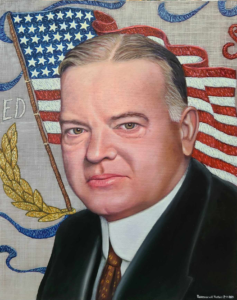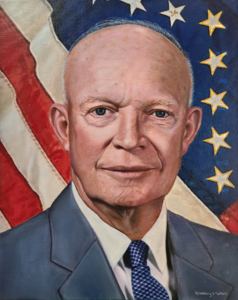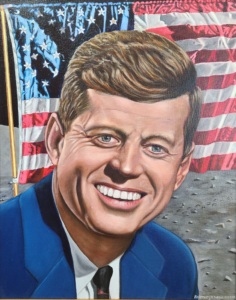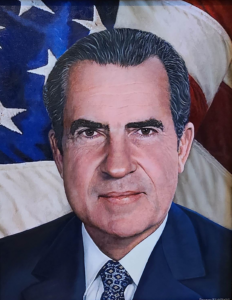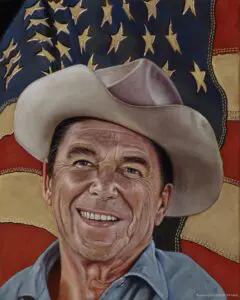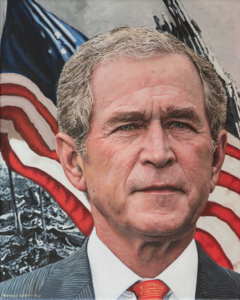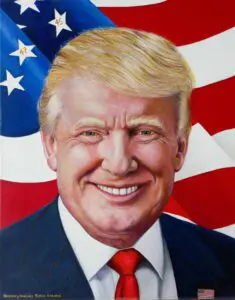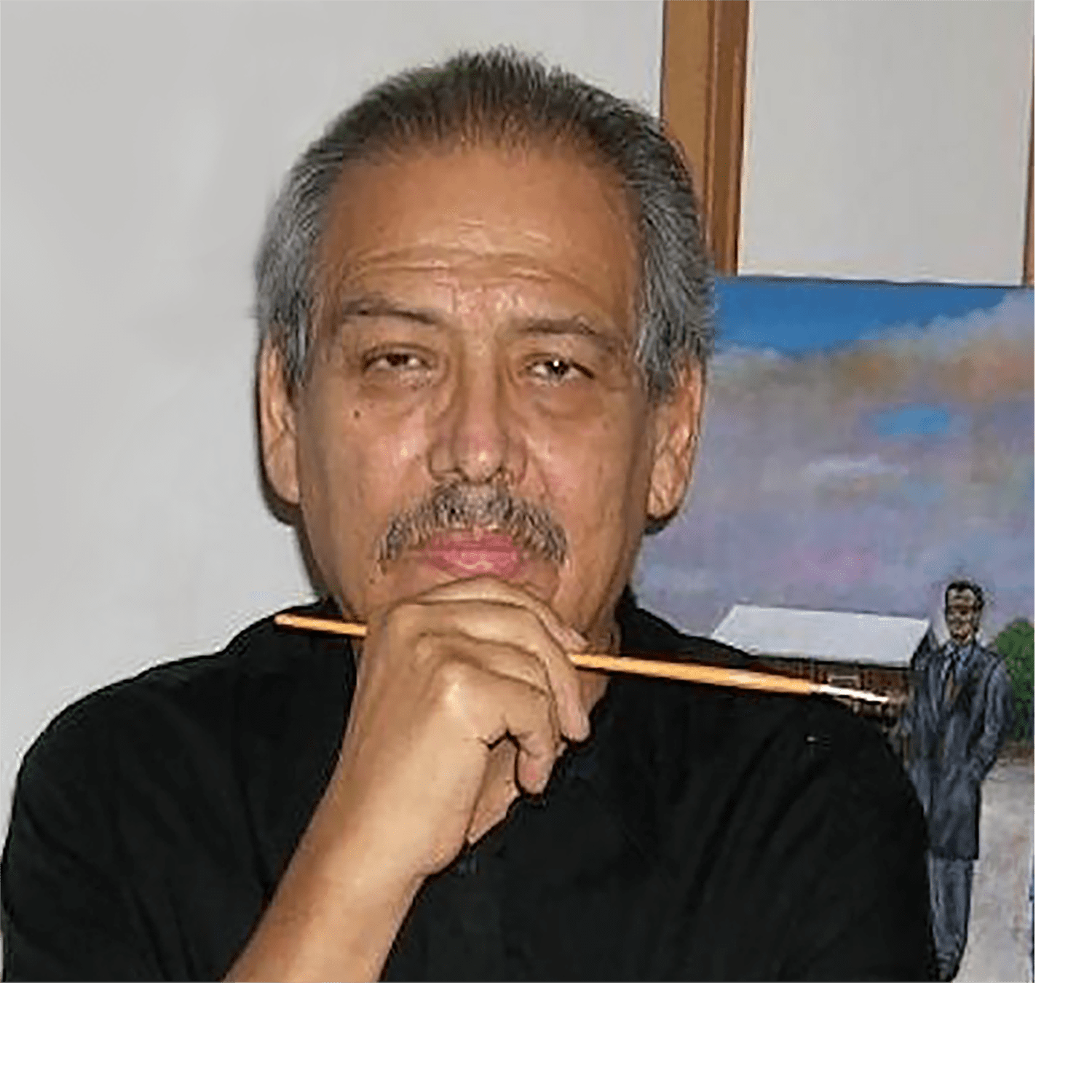An Artist and a Technlologist Make a Mural

George Washington (1789-1797)
George Washington was born on February 22, 1732, in Westmoreland County, Virginia. As the commander-in-chief of the Continental Army during the American Revolution, he led the colonies to victory over Great Britain, securing independence for the United States. His leadership and strategic abilities earned him widespread admiration, and he became known as the "Father of His Country."
In 1787, Washington presided over the Constitutional Convention in Philadelphia, where he played a crucial role in shaping the new government. His integrity and unifying presence made him the clear choice to become the nation’s first president. In 1789, he was unanimously elected and served two terms from 1789 to 1797. His administration established key precedents, including the formation of the executive cabinet and the peaceful transfer of power.
As president, Washington focused on stabilizing the young nation, strengthening its financial system, and maintaining neutrality in European conflicts. His Farewell Address in 1796 warned against political divisions and foreign entanglements, shaping U.S. policy for generations.
After leaving office, Washington returned to his estate at Mount Vernon, where he spent his final years managing his plantation. He passed away on December 14, 1799, at the age of 67. His legacy as a unifying leader, military strategist, and statesman remains a cornerstone of American history.
Thomas Jefferson (1801-1809)
Thomas Jefferson was born on April 13, 1743, in Shadwell, Virginia. A key figure in the founding of the United States, he was the principal author of the Declaration of Independence, defining the nation’s ideals of liberty and equality. A passionate advocate for democracy, Jefferson played a crucial role in shaping the early republic.
Jefferson served as the U.S. Minister to France, succeeding Benjamin Franklin, and later became the first Secretary of State under President George Washington. In the presidential election of 1796, he ran against John Adams and, under the electoral system at the time, became vice president after finishing second in votes. In the highly contested election of 1800, he defeated Adams, becoming the third president of the United States.
One of the defining achievements of his presidency was the Louisiana Purchase in 1803, which doubled the size of the nation. His administration also commissioned the Lewis and Clark Expedition to explore and map the newly acquired western territories. Jefferson championed limited government, individual rights, and public education, later founding the University of Virginia.
After serving two terms, he retired to Monticello, where he pursued interests in architecture, philosophy, and agriculture. He passed away on July 4, 1826, at the age of 83—the same day as his longtime political rival and friend, John Adams—both men dying on the 50th anniversary of American independence. His legacy endures as a champion of democracy, intellectual freedom, and westward expansion.
Abraham Lincoln (1861-1865)
Abraham Lincoln was born on February 12, 1809, in a log cabin in Hardin County, Kentucky (now LaRue County). Raised in the frontier wilderness of Indiana, he had little formal education but was a self-taught reader with a deep curiosity and strong moral compass. These qualities led him to study law and enter politics.
Lincoln served in the Illinois state legislature and later in the U.S. House of Representatives before gaining national attention for his debates with Stephen A. Douglas over slavery. In 1860, he was elected the 16th president of the United States, becoming the first Republican to hold the office. His election triggered the secession of several Southern states, leading to the Civil War.
Determined to preserve the Union, Lincoln led the nation through its greatest internal conflict with unwavering resolve. In 1863, he issued the Emancipation Proclamation, declaring freedom for enslaved people in Confederate-held territories, redefining the war’s purpose. Later that year, his Gettysburg Address became one of the most famous speeches in American history, reaffirming the nation’s commitment to liberty and equality.
Re-elected in 1864, Lincoln sought to reunify the country through a lenient Reconstruction policy. However, his vision was tragically cut short when he was assassinated by John Wilkes Booth at Ford’s Theatre on April 14, 1865.
Lincoln’s leadership preserved the Union, ended slavery, and reshaped America’s future. His legacy remains a lasting symbol of freedom, equality, and democracy.
Ulysses S. Grant (1869-1877)
Ulysses S. Grant was born on April 27, 1822, in Point Pleasant, Ohio, and raised in Georgetown. He attended the United States Military Academy at West Point, graduating in 1843. Grant served in the Mexican-American War but left the Army in 1854, facing years of financial struggles before the Civil War reshaped his destiny.
With the outbreak of the Civil War in 1861, Grant rejoined the military and quickly rose through the ranks due to his strategic skill and determination. His victories at Fort Donelson, Vicksburg, and Chattanooga earned him national recognition, and in 1864, President Abraham Lincoln appointed him General-in-Chief of the Union Army. Grant’s relentless campaign against Confederate forces led to Robert E. Lee’s surrender at Appomattox Court House on April 9, 1865, bringing an end to the war.
In 1868, Grant was elected as the 18th president of the United States. His administration focused on Reconstruction, civil rights for freed slaves, and economic growth. However, his presidency was also plagued by corruption and political scandals, which overshadowed some of his efforts.
After serving two terms, Grant traveled the world, receiving international acclaim. Later, financial ruin forced him to write his memoirs, which became a literary and financial success. He passed away on July 23, 1885, at the age of 63. Grant’s legacy endures as a military leader who preserved the Union and a president who sought to uphold the ideals of freedom and national unity.
Theodore Roosevelt (1901-1909)
Theodore Roosevelt was born on October 27, 1858, in New York City. A sickly child, he overcame his health struggles through rigorous physical activity and developed a deep love for the outdoors. He attended Harvard University and later studied law at Columbia University before entering public service.
His political career began in the New York State Assembly, followed by roles as New York City’s Police Commissioner and Assistant Secretary of the Navy. When the Spanish-American War broke out in 1898, Roosevelt resigned to lead the Rough Riders, a volunteer cavalry unit that gained fame in the Battle of San Juan Hill. His wartime heroism made him a national figure.
Elected governor of New York in 1898, Roosevelt was chosen as William McKinley’s running mate in 1900. After McKinley’s assassination in 1901, Roosevelt, at age 42, became the youngest president in U.S. history. As the 26th president, he pursued progressive reforms, breaking up monopolies, regulating big business, and advocating for consumer protection. His "Square Deal" policies aimed to ensure fairness for workers, businesses, and consumers.
A passionate conservationist, Roosevelt expanded the national parks system, established national monuments, and signed the Antiquities Act to preserve historic and natural sites. He was also instrumental in the construction of the Panama Canal, enhancing global trade and military mobility.
After leaving office in 1909, Roosevelt remained politically active and ran for president again in 1912 as a third-party candidate under the Progressive "Bull Moose" Party. Though he lost, his influence on American politics endured. He continued his adventurous pursuits, including an expedition to the Amazon. Roosevelt died on January 6, 1919, at the age of 60. His legacy as a reformer, conservationist, and advocate for American strength remains significant.
Herbert Hoover (1929-1933)
Herbert Hoover was born on August 10, 1874, in West Branch, Iowa. He was the 31st president of the United States, serving from 1929 to 1933. Orphaned at a young age, he was raised by relatives and developed a strong work ethic that led him to study engineering at Stanford University as part of its inaugural class.
Before entering politics, Hoover made a name for himself as a successful mining engineer, working around the world in countries such as Australia and China. His expertise and leadership in humanitarian efforts during World War I, particularly as head of the U.S. Food Administration, earned him national recognition. He later served as Secretary of Commerce under Presidents Warren G. Harding and Calvin Coolidge, where he championed economic modernization and public-private cooperation.
In 1928, Hoover was elected president, promising continued prosperity. However, just months after taking office, the stock market crashed in October 1929, marking the beginning of the Great Depression. Despite his efforts to stabilize the economy through public works programs, loans to banks, and encouragement of private relief efforts, Hoover’s response was widely criticized as inadequate. Many Americans blamed him for the worsening crisis, and "Hoovervilles," shantytowns for the unemployed, became symbols of the economic hardship.
In 1932, he was overwhelmingly defeated by Franklin D. Roosevelt. After leaving office, Hoover remained active in public service, contributing to government commissions and writing extensively on policy and history. He regained public admiration in later years for his humanitarian efforts, particularly in food relief programs following World War II. Hoover passed away on October 20, 1964, at the age of 90, leaving a complex legacy of both economic hardship and global humanitarian service.
Franklin D. Roosevelt (1933-1945)
Franklin Delano Roosevelt was born on January 30, 1882, in Hyde Park, New York. Coming from a wealthy and influential family, he attended Harvard University and later studied law at Columbia. Inspired by his distant cousin, President Theodore Roosevelt, he entered politics, winning a seat in the New York State Senate in 1910. He later served as Assistant Secretary of the Navy under President Woodrow Wilson, contributing to naval expansion during World War I.
In 1921, Roosevelt was diagnosed with polio, leaving him partially paralyzed. Despite this challenge, he remained active in politics and worked tirelessly to return to public service. Elected Governor of New York in 1928, he implemented progressive reforms that gained national recognition. His leadership during the early years of the Great Depression positioned him as a strong presidential candidate.
Elected as the 32nd president in 1932, Roosevelt took office during a time of economic collapse. He launched the New Deal, a series of programs aimed at recovery, job creation, and financial reform. His "Fireside Chats" reassured the public, and initiatives like Social Security, the Civilian Conservation Corps, and the Works Progress Administration reshaped the role of the federal government.
Re-elected three times, Roosevelt was the only U.S. president to serve four terms. As World War II erupted, he supported the Allies and, following the attack on Pearl Harbor, led the U.S. into war. He worked closely with Winston Churchill and Joseph Stalin to plan military strategy and post-war reconstruction.
Despite declining health, Roosevelt played a key role in establishing the United Nations. On April 12, 1945, he died in Warm Springs, Georgia, before the war’s end. His leadership through the Great Depression and World War II solidified his legacy as one of the most influential presidents in American history.
Dwight D. Eisenhower (1953-1961)
Dwight David Eisenhower was born on October 14, 1890, in Denison, Texas. He was a five-star general in the U.S. Army before becoming the 34th president of the United States. Raised in Abilene, Kansas, Eisenhower’s leadership skills were evident early on, leading him to attend the United States Military Academy at West Point, where he graduated in 1915.During World War II, Eisenhower rose to prominence as Supreme Commander of the Allied Expeditionary Force in Europe.
He was responsible for planning and executing Operation Overlord (D-Day) on June 6, 1944, which led to the liberation of Nazi-occupied Europe. His military success made him a national hero.In the 1952 presidential election, Eisenhower, a Republican, defeated Adlai Stevenson, promising to bring peace to Korea, combat communism, and strengthen the U.S. economy. He was re-elected in 1956. His presidency was marked by the interstate highway system, the creation of NASA, and the Eisenhower Doctrine, which asserted U.S. influence in the Middle East to counter Soviet expansion.
Eisenhower also played a crucial role in enforcing the desegregation of schools, particularly during the Little Rock Crisis of 1957.After two terms in office, Eisenhower retired to his farm in Gettysburg, Pennsylvania, where he remained active in political affairs and wrote his memoirs. He passed away on March 28, 1969, at the age of 78. His legacy remains one of military leadership, Cold War diplomacy, and domestic progress.
John F. Kennedy (1961-1963)
John Fitzgerald Kennedy was born on May 29, 1917, in Brookline, Massachusetts. Raised in a politically influential family, he attended Harvard University, graduating in 1940. During World War II, he served as a naval officer in the Pacific, commanding PT-109. After his boat was struck by a Japanese destroyer, his heroic leadership earned him the Navy and Marine Corps Medal.
Following the war, Kennedy entered politics, serving in the U.S. House of Representatives from 1947 to 1953 and then as a U.S. Senator from Massachusetts. His charisma and ability to connect with the American people made him a rising Democratic star. In 1960, he ran against Vice President Richard Nixon and won one of the closest elections in U.S. history, becoming the youngest elected president and the first Roman Catholic to hold office.
As the 35th president, Kennedy inspired the nation with his call to service, stating in his inaugural address, “Ask not what your country can do for you—ask what you can do for your country.” His administration, often called "Camelot," emphasized civil rights, space exploration, and Cold War diplomacy.
Kennedy championed civil rights legislation and launched the Apollo space program, setting a goal to land a man on the moon. He navigated the Cuban Missile Crisis, securing the removal of Soviet nuclear missiles from Cuba, and promoted global service through the Peace Corps.
On November 22, 1963, Kennedy was assassinated in Dallas, Texas. His death shocked the world, and he was laid to rest at Arlington National Cemetery, where the Eternal Flame marks his grave. Though his presidency was brief, his legacy of hope, leadership, and vision continues to inspire generations.
Richard Nixon (1969-1974)
Richard Milhous Nixon was born on January 9, 1913, in Yorba Linda, California. Raised in a hardworking Quaker family, he excelled academically, attending Whittier College before earning a law degree from Duke University in 1937. He briefly practiced law before serving in the U.S. Navy during World War II.
After the war, Nixon entered politics, winning a seat in the U.S. House of Representatives in 1946. He gained national attention for his anti-communist stance during the Alger Hiss case and was elected to the Senate in 1950. In 1952, he became Dwight D. Eisenhower’s running mate, serving as vice president from 1953 to 1961. He played a key role in Cold War diplomacy and domestic policy.
In 1960, Nixon lost the presidency to John F. Kennedy in a historically close election. After a failed 1962 California gubernatorial bid, he staged a political comeback, winning the presidency in 1968. He was re-elected in 1972 in a landslide victory.
As the 37th president, Nixon pursued historic foreign policy initiatives, opening diplomatic relations with China, easing tensions with the Soviet Union, and ending U.S. involvement in Vietnam. Domestically, he established the Environmental Protection Agency and supported civil rights reforms.
However, his presidency was marred by the Watergate scandal. Facing impeachment, Nixon resigned on August 8, 1974. His successor, Gerald Ford, granted him a full pardon.
Nixon spent his later years writing, advising leaders, and shaping his legacy. He died on April 22, 1994, at 81. His presidency remains one of both historic accomplishments and deep controversy.
Ronald Reagan (1981-1989)
Ronald Wilson Reagan was born on February 6, 1911, in Tampico, Illinois. Raised in a modest household, he developed a strong work ethic and passion for storytelling. After graduating from Eureka College in 1932, he became a radio sports announcer before transitioning to Hollywood, appearing in over 50 films during the 1930s and 1940s.
Originally a New Deal Democrat, Reagan’s political views shifted toward conservatism. His 1964 speech, “A Time for Choosing,” launched his political career, leading to his election as governor of California in 1966. He served two terms, focusing on tax reform, education, and limiting government intervention.
Reagan won the presidency in 1980, defeating Jimmy Carter. As the 40th president, he championed supply-side economics, known as "Reaganomics," promoting tax cuts, deregulation, and military expansion. He took a hard stance against communism, famously calling the Soviet Union the “Evil Empire.” His diplomacy with Mikhail Gorbachev led to arms reduction agreements and contributed to ending the Cold War.
His presidency faced challenges, including the Iran-Contra affair, but his optimism earned him the title "The Great Communicator." After leaving office in 1989, Reagan retired to California. In 1994, he revealed his Alzheimer’s diagnosis and lived in quiet retirement until his passing on June 5, 2004, at age 93. His legacy endures in American politics and conservative thought.
George W. Bush (2001-2009)
George Walker Bush was born on July 6, 1946, in New Haven, Connecticut. The son of future President George H.W. Bush, he grew up in Texas and attended Yale University, graduating in 1968. He later earned an MBA from Harvard Business School, becoming the first U.S. president with an MBA.
Bush served as a pilot in the Texas Air National Guard before pursuing a career in business. He worked in the oil industry and later co-owned the Texas Rangers baseball team. His political career began when he was elected governor of Texas in 1994, serving two terms and focusing on education reform and tax cuts.
In the 2000 presidential election, Bush won a tightly contested race against Al Gore. As the 43rd president, his early administration focused on tax cuts, education reform, and faith-based initiatives. However, the terrorist attacks on September 11, 2001, defined his presidency. He launched the War on Terror, leading to military operations in Afghanistan and Iraq. The invasion of Iraq in 2003, aimed at removing Saddam Hussein, became a major foreign policy controversy.
Domestically, Bush faced challenges including Hurricane Katrina and the 2008 financial crisis. He left office in 2009, returning to Texas, where he focused on humanitarian efforts and painting. His presidency remains influential in modern American politics, particularly in foreign policy and national security.
Donald J. Trump (2017-2021, 2025-Present)
Donald John Trump, born on June 14, 1946, in Queens, New York, is the 45th and 47th president of the United States. He is the second individual, after Grover Cleveland, to serve non-consecutive terms. Raised in a prominent real estate family, Trump graduated from the Wharton School of the University of Pennsylvania in 1968 with a degree in economics. He joined the family business, eventually rebranding it as the Trump Organization, and expanded into various ventures, including real estate, casinos, and entertainment. From 2004 to 2015, he gained national fame as the host of the reality TV show "The Apprentice."
In 2016, Trump entered politics as a Republican outsider and won the presidency against Democratic nominee Hillary Clinton. His first term (2017–2021) was marked by significant policy changes, including tax reforms, deregulation, and a conservative shift in the judiciary with three Supreme Court appointments. His administration faced controversies, notably two impeachments: the first in 2019 on charges of abuse of power and obstruction of Congress, and the second in 2021 for incitement of insurrection; he was acquitted in both trials.
After losing the 2020 election to Joe Biden, Trump remained a dominant figure in the Republican Party. Despite legal challenges, including a 2024 conviction for falsifying business records, he ran for president again and defeated Democratic nominee Kamala Harris in the 2024 election. He was inaugurated on January 20, 2025, with JD Vance as his vice president. Early in his second term, Trump focused on reversing his predecessor's policies, particularly in immigration and energy, and his focus is on reducing the size of government and addressing fraudulent and wasted spending. His leadership continues to influence American politics and conservatism.





